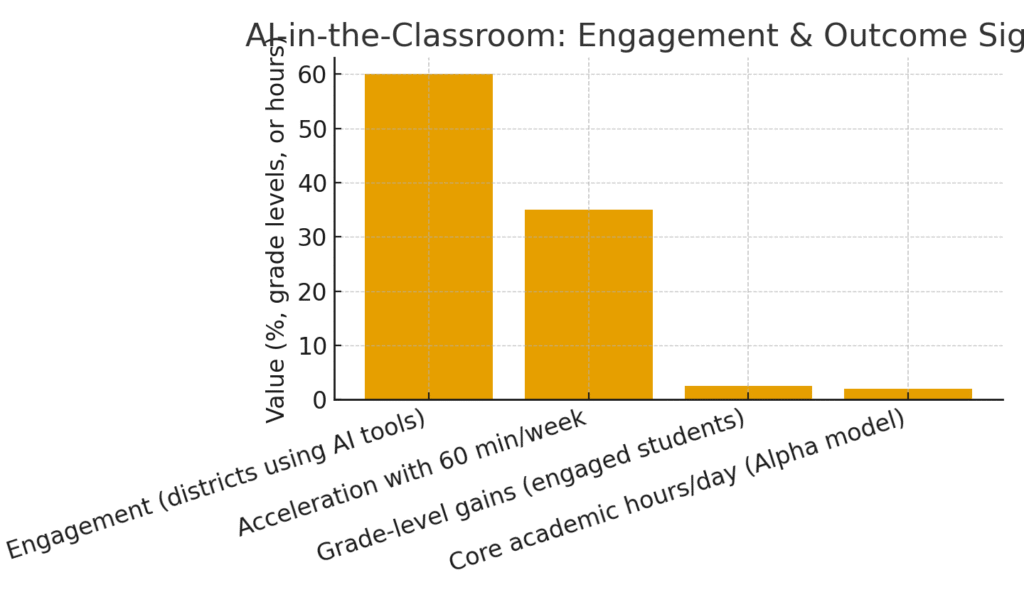Teachers First: How AI Is Reshaping Classrooms Without Replacing Educators (2025)
AI can accelerate learning—but only when teachers orchestrate the experience. Here’s what Salman Khan says about engagement, cheating, and designing classrooms for the AI era.
Quick Summary
- Teachers remain the “game mechanic.” Districts that invest in coaching and celebrate high-engagement teachers see far better outcomes.
- 50–70% engagement is achievable at scale when leadership tracks usage and supports classrooms, with math scores rising in case studies.
- Even 60 minutes/week of guided practice with AI tools correlates with 30–40% faster progress in efficacy studies.
- Some models compress core academics into 2 hours/day of high-feedback practice, freeing time for projects, dialogue, and life skills.
Introduction
After a decade of education technology cycles, the new AI wave forces a simple question: Can software finally deliver sustained gains in student learning? According to Khan Academy CEO Salman Khan, the answer is a qualified yes—but only if teachers lead. In partnerships now reaching about 1.5 million students, Khan argues that the highest-performing districts treat AI as an amplifier of good instruction rather than a substitute for it. They track engagement, cheer on early adopters, and give time for professional development, creating a culture where practice and feedback become daily habits.
This is not a purely American story. Around the world, education systems wrestle with post-pandemic learning gaps, teacher workload, and uneven digital access. The key lesson from U.S. districts that are succeeding with AI is strikingly universal: engagement is designed, not assumed. That design lives in routines, coaching, and accountability—things software alone cannot provide. fileciteturn0file0
Summary Statistics
| Metric | Value | Context |
|---|---|---|
| Students in formal AI partnerships | ~1.5 million | Khanmigo and related tools used in districts/classrooms. |
| District engagement (target range) | 50–70% of students | High-engagement classrooms correlated with rising math scores. |
| Weekly practice threshold | 60 minutes/week | Associated with 30–40% faster progress. |
| Acceleration vs. typical progress | +30–40% | Based on efficacy studies in AI-supported practice regimes. |
| Grade-level gains (engaged students) | 2–3 per year | Reported at Khan Lab School / Khan World School. |
| Core academic time (Alpha-school model) | 2 hours/day | Concentrated AI-guided practice + feedback, plus projects after. |
| Academic integrity response | In-class/proctored writing | When the goal is assessing students’ own thinking, not tool use. |
| Tech culture | “Analog hour,” no student phones | Intentional limits to build focus, grit, and non-digital habits. |
All figures are synthesized from the provided interview and commentary; midpoints are used for visualizations when ranges are given.
Analysis & Insights
Engagement is the leading indicator. Khan’s central claim is that no tool—no matter how sophisticated—will move outcomes unless teachers orchestrate routines that keep students practicing and receiving feedback. Successful districts do three simple things: measure classroom-level engagement, celebrate the teachers who achieve it, and support those who don’t. The result in Newark, New Jersey, and similar contexts: participation rates above 50%, approaching 70%, and upward movement in math scores—an uncommon trend among large, urban districts.
AI reframes assessment, not just instruction. Cheating via large language models is real; pretending otherwise erodes trust. The remedy is not a blanket ban but assessment design: use proctored in-class writing when you want to see a student’s unaided reasoning, and assign projects that explicitly require AI for research, drafting, and iteration when tool use is the skill. This dual-track approach mirrors workplaces, where summarization and ideation tools are increasingly standard.
Time is reallocated, not “saved.” In high-intensity models (e.g., Alpha schools), core academics compress into two hours of concentrated, feedback-rich practice. The rest of the day shifts to socratic seminars, projects, and life skills. Khan’s own schools emphasize deliberate offline time—“analog hour” and phone-free policies—to build attention and resilience alongside digital fluency.
Minimum effective dose matters. Efficacy studies suggest that even one hour per week of well-structured AI-supported practice can lift progress by 30–40%. For systems struggling with teacher shortages and uneven preparedness, that kind of dose-response curve is strategically important: it’s scalable, measurable, and compatible with existing curricula.

Implementation playbook. For leaders planning rollouts this academic year, three moves offer outsized returns: (1) Define an engagement KPI (e.g., % of students meeting the 60-min/week practice threshold); (2) Build a recognition loop that spotlights classrooms and schools achieving growth; (3) Schedule staff time for modeling prompts, reviewing AI-generated feedback, and staging in-class writing checks. None of this requires perfect tech—it requires consistent habits.
Conclusion & Key Takeaways
- Teachers are the multiplier: AI works when educators design and sustain engagement routines.
- Small, steady doses compound: 60 minutes/week can deliver 30–40% faster progress.
- Assess what you intend to measure: Proctored writing for independent thinking; projects that expect AI when tool use is the skill.
- Balance screens with human work: Deliberate analog time builds attention, grit, and community.
Source: Interview and commentary provided by the user. Compiled on September 02, 2025.